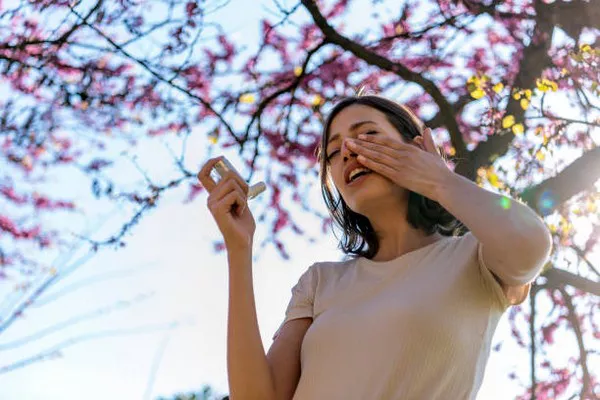Cedar fever, also known as mountain cedar allergy, is a common seasonal allergy that affects many individuals, particularly in regions where cedar trees are prevalent. Characterized by a range of symptoms, cedar fever can significantly impact an individual’s quality of life during peak cedar pollen seasons. This article aims to provide a comprehensive overview of cedar fever, including its symptoms, treatment options, and strategies for prevention.
Cedar Fever:
Cedar fever is a term used to describe the allergic response triggered by exposure to pollen from cedar trees. While the term “cedar fever” may suggest flu-like symptoms, it is important to note that cedar fever is not caused by a virus or bacteria. Instead, it is an allergic reaction to the pollen released by cedar trees, primarily the Ashe juniper (Juniperus ashei) species found in parts of the United States, particularly in central Texas.
Symptoms of Cedar Fever:
The symptoms of cedar fever can vary in severity from mild to severe and may resemble those of the common cold or flu. Common symptoms include:
Nasal congestion: Cedar pollen can irritate the nasal passages, leading to congestion and difficulty breathing through the nose.
Sneezing: Excessive sneezing is a common symptom of cedar fever, as the body attempts to expel allergens from the nasal passages.
Runny or stuffy nose: Cedar pollen can trigger an increase in mucus production, resulting in a runny or stuffy nose.
Itchy or watery eyes: Cedar pollen can also cause irritation to the eyes, leading to itching, redness, and excessive tearing.
Coughing: Some individuals with cedar fever may experience a persistent cough as a result of postnasal drip.
Sore throat: Irritation of the throat caused by postnasal drip or coughing may result in a sore throat.
Fatigue: Cedar fever can cause fatigue and lethargy, making it difficult for individuals to carry out their daily activities.
Headache: Some individuals may experience headaches as a result of sinus pressure and congestion caused by cedar pollen.
It is important to note that not everyone exposed to cedar pollen will develop cedar fever, and the severity of symptoms can vary from person to person. Individuals with pre-existing respiratory conditions such as asthma or allergic rhinitis may experience more severe symptoms.
Treatment Options:
While there is no cure for cedar fever, several treatment options are available to alleviate symptoms and improve quality of life during cedar pollen seasons. Treatment options may include:
Over-the-counter antihistamines: Antihistamines such as loratadine, cetirizine, or fexofenadine can help reduce symptoms such as sneezing, itching, and nasal congestion.
Nasal corticosteroids: Intranasal corticosteroid sprays such as fluticasone or mometasone can help reduce inflammation in the nasal passages and alleviate symptoms of congestion and nasal discharge.
Decongestants: Oral or nasal decongestants can help alleviate nasal congestion by shrinking swollen nasal tissues. However, decongestants should be used with caution, as they may cause rebound congestion with prolonged use.
Nasal saline irrigation: Nasal saline irrigation can help flush out allergens and mucus from the nasal passages, providing temporary relief from symptoms.
Allergy shots (immunotherapy): Allergy shots may be recommended for individuals with severe cedar fever symptoms that do not respond to other treatments. Allergy shots work by gradually desensitizing the immune system to cedar pollen, reducing the severity of allergic reactions over time.
It is essential to consult a healthcare professional before starting any treatment regimen, as they can provide personalized recommendations based on individual medical history and allergy severity.
Prevention Strategies:
While it may be challenging to completely avoid cedar pollen, especially during peak pollen seasons, several strategies can help reduce exposure and minimize the risk of developing cedar fever symptoms:
Stay indoors during peak pollen times: Cedar pollen levels are typically highest in the early morning and on windy days. Whenever possible, try to stay indoors during these times to reduce exposure to pollen.
Keep windows closed: Keep windows and doors closed during peak pollen seasons to prevent pollen from entering your home.
Use air purifiers: Consider using HEPA air purifiers in your home to help remove pollen and other allergens from the air.
Change clothes after outdoor activities: After spending time outdoors, change clothes and shower to remove pollen from your skin and hair.
Use allergy-friendly landscaping: If possible, avoid planting cedar trees or other high-pollen plants near your home. Instead, opt for low-pollen plants that are less likely to trigger allergic reactions.
Monitor pollen counts: Stay informed about local pollen counts and take precautions when pollen levels are high. Many weather websites and apps provide up-to-date pollen forecasts for your area.
By implementing these prevention strategies and seeking appropriate treatment, individuals with cedar fever can effectively manage their symptoms and improve their quality of life during cedar pollen seasons.
See Also: 7 Trees That Trigger Hay Fever & Strategies for Management
Conclusion:
Cedar fever is a common seasonal allergy characterized by symptoms such as nasal congestion, sneezing, and itchy eyes. While there is no cure for cedar fever, several treatment options are available to alleviate symptoms and improve quality of life. Additionally, adopting preventive measures such as staying indoors during peak pollen times and using air purifiers can help reduce exposure to cedar pollen and minimize the risk of developing symptoms. By working with healthcare professionals and implementing appropriate treatment and prevention strategies, individuals with cedar fever can effectively manage their allergies and lead healthier lives.


